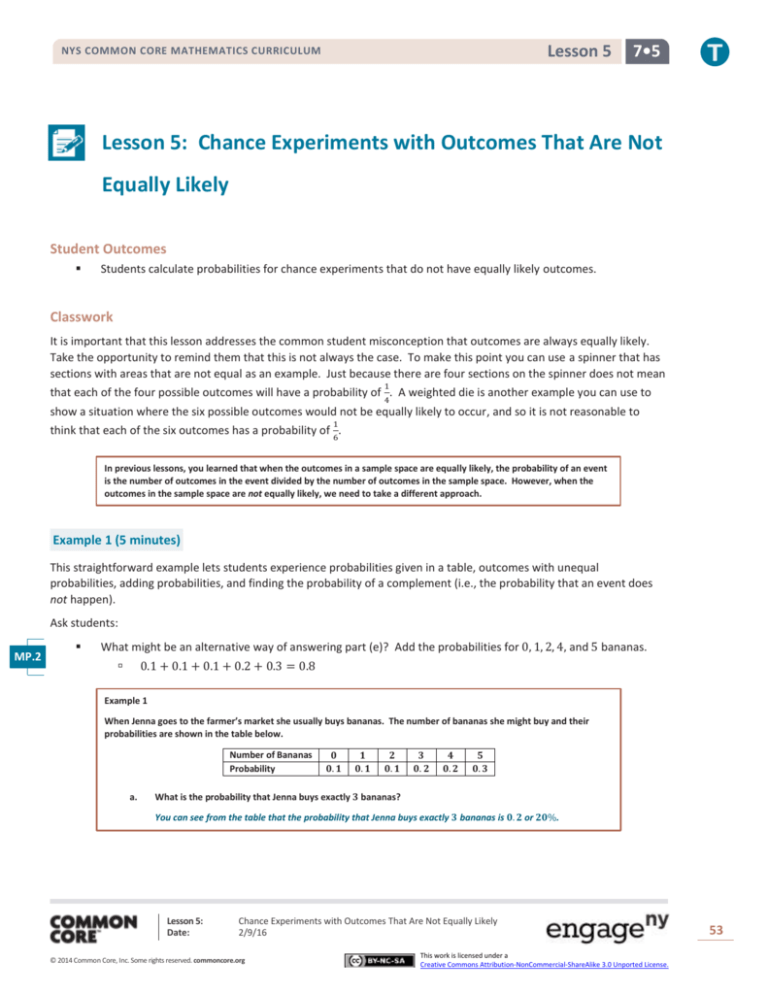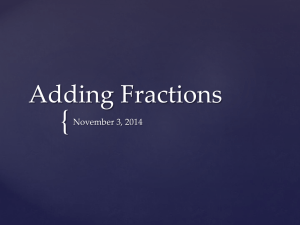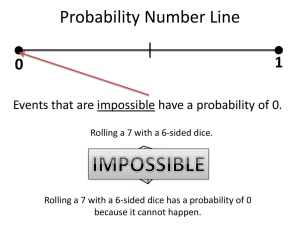
Lesson 5
NYS COMMON CORE MATHEMATICS CURRICULUM
7•5
Lesson 5: Chance Experiments with Outcomes That Are Not
Equally Likely
Student Outcomes
Students calculate probabilities for chance experiments that do not have equally likely outcomes.
Classwork
It is important that this lesson addresses the common student misconception that outcomes are always equally likely.
Take the opportunity to remind them that this is not always the case. To make this point you can use a spinner that has
sections with areas that are not equal as an example. Just because there are four sections on the spinner does not mean
1
that each of the four possible outcomes will have a probability of . A weighted die is another example you can use to
4
show a situation where the six possible outcomes would not be equally likely to occur, and so it is not reasonable to
1
think that each of the six outcomes has a probability of .
6
In previous lessons, you learned that when the outcomes in a sample space are equally likely, the probability of an event
is the number of outcomes in the event divided by the number of outcomes in the sample space. However, when the
outcomes in the sample space are not equally likely, we need to take a different approach.
Example 1 (5 minutes)
This straightforward example lets students experience probabilities given in a table, outcomes with unequal
probabilities, adding probabilities, and finding the probability of a complement (i.e., the probability that an event does
not happen).
Ask students:
MP.2
What might be an alternative way of answering part (e)? Add the probabilities for 0, 1, 2, 4, and 5 bananas.
0.1 + 0.1 + 0.1 + 0.2 + 0.3 = 0.8
Example 1
When Jenna goes to the farmer’s market she usually buys bananas. The number of bananas she might buy and their
probabilities are shown in the table below.
Number of Bananas
Probability
a.
𝟎
𝟎. 𝟏
𝟏
𝟎. 𝟏
𝟐
𝟎. 𝟏
𝟑
𝟎. 𝟐
𝟒
𝟎. 𝟐
𝟓
𝟎. 𝟑
What is the probability that Jenna buys exactly 𝟑 bananas?
You can see from the table that the probability that Jenna buys exactly 𝟑 bananas is 𝟎. 𝟐 or 𝟐𝟎%.
Lesson 5:
Date:
Chance Experiments with Outcomes That Are Not Equally Likely
2/9/16
© 2014 Common Core, Inc. Some rights reserved. commoncore.org
This work is licensed under a
Creative Commons Attribution-NonCommercial-ShareAlike 3.0 Unported License.
53
Lesson 5
NYS COMMON CORE MATHEMATICS CURRICULUM
b.
7•5
What is the probability that Jenna does not buy any bananas?
The probability that Jenna buys 𝟎 bananas is 𝟎. 𝟏, or 𝟏𝟎%.
c.
What is the probability that Jenna buys more than 𝟑 bananas?
The probability that Jenna buys 𝟒 or 𝟓 bananas is 𝟎. 𝟐 + 𝟎. 𝟑 = 𝟎. 𝟓, or 𝟓𝟎%.
d.
What is the probability that Jenna buys at least 𝟑 bananas?
The probability that Jenna buys 𝟑, 𝟒, or 𝟓 bananas is 𝟎. 𝟐 + 𝟎. 𝟐 + 𝟎. 𝟑 = 𝟎. 𝟕, or 𝟕𝟎%.
e.
What is the probability that Jenna doesn’t buy exactly 𝟑 bananas?
Remember that the probability that an event does not happen is
𝟏 − (𝐭𝐡𝐞 𝐩𝐫𝐨𝐛𝐚𝐛𝐢𝐥𝐢𝐭𝐲 𝐭𝐡𝐚𝐭 𝐭𝐡𝐞 𝐞𝐯𝐞𝐧𝐭 𝐝𝐨𝐞𝐬 𝐡𝐚𝐩𝐩𝐞𝐧).
So, the probability that Jenna does not buy exactly 𝟑 bananas is
𝟏 − (𝐭𝐡𝐞 𝐩𝐫𝐨𝐛𝐚𝐛𝐢𝐥𝐢𝐭𝐲 𝐭𝐡𝐚𝐭 𝐬𝐡𝐞 𝐝𝐨𝐞𝐬 𝐛𝐮𝐲 𝐞𝐱𝐚𝐜𝐭𝐥𝐲 𝟑 𝐛𝐚𝐧𝐚𝐧𝐚𝐬)
𝟏 − 𝟎. 𝟐 = 𝟎. 𝟖.
Notice that the sum of the probabilities in the table is one whole (𝟎. 𝟏 + 𝟎. 𝟏 + 𝟎. 𝟏 + 𝟎. 𝟐 + 𝟎. 𝟐 + 𝟎. 𝟑 = 𝟏). This is
always true; when we add up the probabilities of all the possible outcomes, the result is always 𝟏. So, taking 𝟏 and
subtracting the probability of the event gives us the probability of something NOT occurring.
Exercises 1–2 (6 minutes)
Decide if you want to let students use calculators on this exercise. Doing the exercise using only pencil and paper would
provide useful practice with adding decimals. However, you might decide that the time saved by allowing calculators on
this exercise will give you more time to devote to working with fractions in the examples and exercises that follow. Let
students work independently and confirm their answers with a neighbor.
Exercises 1–2
Jenna’s husband, Rick, is concerned about his diet. On any given day, he eats 𝟎, 𝟏, 𝟐, 𝟑, or 𝟒 servings of fruit and
vegetables. The probabilities are given in the table below.
Number of Servings of Fruit and Vegetables
Probability
1.
𝟎
𝟎. 𝟎𝟖
𝟏
𝟎. 𝟏𝟑
𝟐
𝟎. 𝟐𝟖
𝟑
𝟎. 𝟑𝟗
𝟒
𝟎. 𝟏𝟐
On a given day, find the probability that Rick eats
a.
Two servings of fruit and vegetables.
𝟎. 𝟐𝟖
b.
More than two servings of fruit and vegetables.
𝟎. 𝟑𝟗 + 𝟎. 𝟏𝟐 = 𝟎. 𝟓𝟏
c.
At least two servings of fruit and vegetables.
𝟎. 𝟐𝟖 + 𝟎. 𝟑𝟗 + 𝟎. 𝟏𝟐 = 𝟎. 𝟕𝟗
Lesson 5:
Date:
Chance Experiments with Outcomes That Are Not Equally Likely
2/9/16
© 2014 Common Core, Inc. Some rights reserved. commoncore.org
This work is licensed under a
Creative Commons Attribution-NonCommercial-ShareAlike 3.0 Unported License.
54
Lesson 5
NYS COMMON CORE MATHEMATICS CURRICULUM
2.
7•5
Find the probability that Rick does not eat exactly two servings of fruit and vegetables.
𝟏 − 𝟎. 𝟐𝟖 = 𝟎. 𝟕𝟐
Example 2 (8 minutes)
Here, the concepts in Example 1 are repeated, this time using fractions. This provides an opportunity to remind students
how to add and subtract fractions using common denominators, and how to simplify fractions.
Example 2
Luis works in an office, and the phone rings occasionally. The possible number of phone calls he receives in an afternoon
and their probabilities are given in the table below.
a.
Number of Phone Calls
𝟎
𝟏
𝟐
𝟑
𝟒
Probability
𝟏
𝟔
𝟏
𝟔
𝟐
𝟗
𝟏
𝟑
𝟏
𝟗
Find the probability that Luis receives 𝟑 or 𝟒 phone calls.
The probability that Luis receives 𝟑 or 𝟒 phone calls is
b.
𝟏
𝟑
+
𝟏
𝟗
+
𝟏
𝟗
𝟒
= .
𝟗
𝟏
𝟔
+
𝟏
𝟔
=
𝟐
𝟔
𝟏
= .
𝟑
Find the probability that Luis receives 𝟐 or fewer phone calls.
The probability that Luis receives 𝟐 or fewer phone calls is
d.
𝟗
Find the probability that Luis receives fewer than 𝟐 phone calls.
The probability that Luis receives fewer than 𝟐 phone calls is
c.
𝟑
=
𝟐
+
𝟗
𝟏
𝟔
+
𝟏
𝟔
=
𝟒
𝟏𝟖
+
𝟑
𝟏𝟖
+
𝟑
𝟏𝟖
=
𝟏𝟎
𝟏𝟖
𝟓
= .
𝟗
Find the probability that Luis does not receive 𝟒 phone calls.
The probability that Luis does not receive 𝟒 phone calls is 𝟏 −
𝟏 𝟗 𝟏 𝟖
= − = .
𝟗 𝟗 𝟗 𝟗
If there is time available, ask students:
How would you calculate the probability that Luis receives at least one call? What might be a quicker way of
doing this?
The straightforward answer is to add the probabilities for 1, 2, 3, and 4:
1 2 1 1
3
4
2
15 5
+ + + =
+
+
=
= .
6 9 3 9 18 18 18 18 6
The quicker way is to say that the probability he gets at least one call is the probability that he does not
1
5
get zero calls, and so the required probability is 1 − = .
6
Lesson 5:
Date:
6
Chance Experiments with Outcomes That Are Not Equally Likely
2/9/16
© 2014 Common Core, Inc. Some rights reserved. commoncore.org
This work is licensed under a
Creative Commons Attribution-NonCommercial-ShareAlike 3.0 Unported License.
55
Lesson 5
NYS COMMON CORE MATHEMATICS CURRICULUM
7•5
Exercise 3 (8 minutes)
The main challenge this question presents is adding and subtracting fractions, so it is important that students do not use
calculators on this exercise or on the other questions that involve fractions. Students can either work independently or
with a partner. Teachers should use discretion on how important it is to complete this exercise. This exercise provides
students an opportunity to review their work with fractions.
Exercises 3–7
When Jenna goes to the farmer’s market, she also usually buys some broccoli. The possible number of heads of broccoli
that she buys and the probabilities are given in the table below.
3.
Number of Heads of Broccoli
𝟎
𝟏
𝟐
𝟑
𝟒
Probability
𝟏
𝟏𝟐
𝟏
𝟔
𝟓
𝟏𝟐
𝟏
𝟒
𝟏
𝟏𝟐
Find the probability that Jenna
a.
Buys exactly 𝟑 heads of broccoli.
𝟏
𝟒
b.
Does not buy exactly 𝟑 heads of broccoli.
𝟏 𝟑
𝟏− =
𝟒 𝟒
c.
Buys more than 𝟏 head of broccoli.
𝟓 𝟏 𝟏
𝟑
+ +
=
𝟏𝟐 𝟒 𝟏𝟐 𝟒
d.
Buys at least 𝟑 heads of broccoli.
𝟏 𝟏
𝟏
+
=
𝟒 𝟏𝟐 𝟑
Exercises 4–7 (8 minutes)
Here, students calculate the probabilities of a given scenario. Because this is the first time this is covered in this class,
some students might need assistance.
The diagram below shows a spinner designed like the face of a clock. The sectors of the spinner are colored red (R), blue
(B), green (G), and yellow (Y).
Lesson 5:
Date:
Chance Experiments with Outcomes That Are Not Equally Likely
2/9/16
© 2014 Common Core, Inc. Some rights reserved. commoncore.org
This work is licensed under a
Creative Commons Attribution-NonCommercial-ShareAlike 3.0 Unported License.
56
Lesson 5
NYS COMMON CORE MATHEMATICS CURRICULUM
4.
5.
6.
7•5
Writing your answers as fractions in lowest terms, find the probability that the pointer stops on the following colors.
𝟏
a.
Red:
b.
Blue:
c.
Green:
d.
Yellow:
𝟏𝟐
𝟐
𝟏𝟐
𝟏
=
𝟔
𝟓
𝟏𝟐
𝟒
𝟏𝟐
=
𝟏
𝟑
Complete the table of probabilities below.
Color
Red
Blue
Green
Yellow
Probability
𝟏
𝟏𝟐
𝟏
𝟔
𝟓
𝟏𝟐
𝟏
𝟑
Find the probability that the pointer stops in either the blue region or the green region.
𝟏 𝟓
𝟕
+
=
𝟔 𝟏𝟐 𝟏𝟐
MP.4
7.
Find the probability that the pointer does not stop in the green region.
𝟏−
𝟓
𝟕
=
𝟏𝟐 𝟏𝟐
Closing (5 minutes)
Discuss with students the Lesson Summary.
Lesson Summary
In a probability experiment where the outcomes are not known to be equally likely, the formula for the probability
of an event does not necessarily apply:
𝑷(𝐞𝐯𝐞𝐧𝐭) =
𝐍𝐮𝐦𝐛𝐞𝐫 𝐨𝐟 𝐨𝐮𝐭𝐜𝐨𝐦𝐞𝐬 𝐢𝐧 𝐭𝐡𝐞 𝐞𝐯𝐞𝐧𝐭
.
𝐍𝐮𝐦𝐛𝐞𝐫 𝐨𝐟 𝐨𝐮𝐭𝐜𝐨𝐦𝐞𝐬 𝐢𝐧 𝐭𝐡𝐞 𝐬𝐚𝐦𝐩𝐥𝐞 𝐬𝐩𝐚𝐜𝐞
For example:
To find the probability that the score is greater than 𝟑, add the probabilities of all the scores that are
greater than 𝟑.
To find the probability of not getting a score of 𝟑, calculate 𝟏 − (𝐭𝐡𝐞 𝐩𝐫𝐨𝐛𝐚𝐛𝐢𝐥𝐢𝐭𝐲 𝐨𝐟 𝐠𝐞𝐭𝐭𝐢𝐧𝐠 𝐚 𝟑).
Exit Ticket (5 minutes)
Lesson 5:
Date:
Chance Experiments with Outcomes That Are Not Equally Likely
2/9/16
© 2014 Common Core, Inc. Some rights reserved. commoncore.org
This work is licensed under a
Creative Commons Attribution-NonCommercial-ShareAlike 3.0 Unported License.
57
Lesson 5
NYS COMMON CORE MATHEMATICS CURRICULUM
Name ___________________________________________________
7•5
Date____________________
Lesson 5: Chance Experiments with Outcomes That Are Not
Equally Likely
Exit Ticket
Carol is sitting on the bus on the way home from school and is thinking about the fact that she has three homework
assignments to do tonight. The table below shows her estimated probabilities of completing 0, 1, 2, or all 3 of the
assignments.
1.
Number of Homework Assignments Completed
0
1
2
3
Probability
1
6
2
9
5
18
1
3
Writing your answers as fractions in lowest terms, find the probability that Carol completes
a.
Exactly one assignment.
b.
More than one assignment.
c.
At least one assignment.
2.
Find the probability that the number of homework assignments Carol completes is not exactly 2.
3.
Carol has a bag containing 3 red chips, 10 blue chips, and 7 green chips. Estimate the probability (as a fraction or
decimal) of Carol reaching into her bag and pulling out a green chip.
Lesson 5:
Date:
Chance Experiments with Outcomes That Are Not Equally Likely
2/9/16
© 2014 Common Core, Inc. Some rights reserved. commoncore.org
This work is licensed under a
Creative Commons Attribution-NonCommercial-ShareAlike 3.0 Unported License.
58
Lesson 5
NYS COMMON CORE MATHEMATICS CURRICULUM
7•5
Exit Ticket Sample Solutions
Carol is sitting on the bus on the way home from school and is thinking about the fact that she has three homework
assignments to do tonight. The table below shows her estimated probabilities of completing 𝟎, 𝟏, 𝟐, or all 𝟑 of the
assignments.
1.
Number of Homework Assignments Completed
𝟎
𝟏
𝟐
𝟑
Probability
𝟏
𝟔
𝟐
𝟗
𝟓
𝟏𝟖
𝟏
𝟑
Writing your answers as fractions in lowest terms, find the probability that Carol completes
a.
Exactly one assignment.
𝟐
𝟗
b.
More than one assignment.
𝟓 𝟏
𝟓
𝟔
𝟏𝟏
+ =
+
=
𝟏𝟖 𝟑 𝟏𝟖 𝟏𝟖 𝟏𝟖
c.
At least one assignment.
𝟐 𝟓 𝟏
𝟒
𝟓
𝟔
𝟏𝟓 𝟓
+
+ =
+
+
=
=
𝟗 𝟏𝟖 𝟑 𝟏𝟖 𝟏𝟖 𝟏𝟖 𝟏𝟖 𝟔
2.
Find the probability that the number of homework assignments Carol completes is not exactly 𝟐.
𝟏−
3.
𝟓
𝟏𝟑
=
𝟏𝟖 𝟏𝟖
Carol has a bag containing 𝟑 red chips, 𝟏𝟎 blue chips, and 𝟕 green chips. Estimate the probability (as a fraction or
decimal) of Carol reaching into her bag and pulling out a green chip.
An estimate of the probability would be 𝟕 out of 𝟐𝟎,
𝟕
, or 𝟎. 𝟑𝟓.
𝟐𝟎
Problem Set Sample Solutions
1.
The Gator Girls are a soccer team. The possible number of goals the Gator Girls will score in a game and their
probabilities are shown in the table below.
Number of Goals
Probability
𝟎
𝟎. 𝟐𝟐
𝟏
𝟎. 𝟑𝟏
𝟐
𝟎. 𝟑𝟑
𝟑
𝟎. 𝟏𝟏
𝟒
𝟎. 𝟎𝟑
Find the probability that the Gator Girls:
a.
Score more than two goals.
𝟎. 𝟏𝟏 + 𝟎. 𝟎𝟑 = 𝟎. 𝟏𝟒
b.
Score at least two goals.
𝟎. 𝟑𝟑 + 𝟎. 𝟏𝟏 + 𝟎. 𝟎𝟑 = 𝟎. 𝟒𝟕
Lesson 5:
Date:
Chance Experiments with Outcomes That Are Not Equally Likely
2/9/16
© 2014 Common Core, Inc. Some rights reserved. commoncore.org
This work is licensed under a
Creative Commons Attribution-NonCommercial-ShareAlike 3.0 Unported License.
59
Lesson 5
NYS COMMON CORE MATHEMATICS CURRICULUM
c.
7•5
Do not score exactly 𝟑 goals.
𝟏 − 𝟎. 𝟏𝟏 = 𝟎. 𝟖𝟗
2.
The diagram below shows a spinner. The pointer is spun, and the player is awarded a prize according to the color on
which the pointer stops.
a.
What is the probability that the pointer stops in the red region?
𝟏
𝟐
b.
c.
Complete the table below showing the probabilities of the three possible results.
Color
Red
Green
Blue
Probability
𝟏
𝟐
𝟏
𝟒
𝟏
𝟒
Find the probability that the pointer stops on green or blue.
𝟏 𝟏 𝟏
+ =
𝟒 𝟒 𝟐
d.
Find the probability that the pointer does not stop on green.
𝟏−
3.
𝟏 𝟑
=
𝟒 𝟒
Wayne asked every student in his class how many siblings (brothers and sisters) they had. Survey results are shown
in the table below. (Wayne included himself in the results.)
Number of Siblings
Number of Students
𝟎
𝟒
𝟏
𝟓
𝟐
𝟏𝟒
𝟑
𝟔
𝟒
𝟑
(Note: The table tells us that 𝟒 students had no siblings, 𝟓 students had one sibling, 𝟏𝟒 students had two siblings,
and so on.)
a.
How many students are in Wayne’s class, including Wayne?
𝟒 + 𝟓 + 𝟏𝟒 + 𝟔 + 𝟑 = 𝟑𝟐
b.
What is the probability that a randomly selected student does not have any siblings? Write your answer as a
fraction in lowest terms.
𝟒
𝟏
=
𝟑𝟐 𝟖
Lesson 5:
Date:
Chance Experiments with Outcomes That Are Not Equally Likely
2/9/16
© 2014 Common Core, Inc. Some rights reserved. commoncore.org
This work is licensed under a
Creative Commons Attribution-NonCommercial-ShareAlike 3.0 Unported License.
60
Lesson 5
NYS COMMON CORE MATHEMATICS CURRICULUM
c.
d.
7•5
The table below shows the possible number of siblings and the probabilities of each number. Complete the
table by writing the probabilities as fractions in lowest terms.
Number of Siblings
𝟎
𝟏
𝟐
𝟑
𝟒
Probability
𝟏
𝟖
𝟓
𝟑𝟐
𝟕
𝟏𝟔
𝟑
𝟏𝟔
𝟑
𝟑𝟐
Writing your answers as fractions in lowest terms, find the probability that the student
i.
Has fewer than two siblings.
𝟏 𝟓
𝟗
+
=
𝟖 𝟑𝟐 𝟑𝟐
ii.
Has two or fewer siblings.
𝟏 𝟓
𝟕
𝟐𝟑
+
+
=
𝟖 𝟑𝟐 𝟏𝟔 𝟑𝟐
iii.
Does not have exactly one sibling.
𝟏−
𝟓
𝟐𝟕
=
𝟑𝟐 𝟑𝟐
Lesson 5:
Date:
Chance Experiments with Outcomes That Are Not Equally Likely
2/9/16
© 2014 Common Core, Inc. Some rights reserved. commoncore.org
This work is licensed under a
Creative Commons Attribution-NonCommercial-ShareAlike 3.0 Unported License.
61








